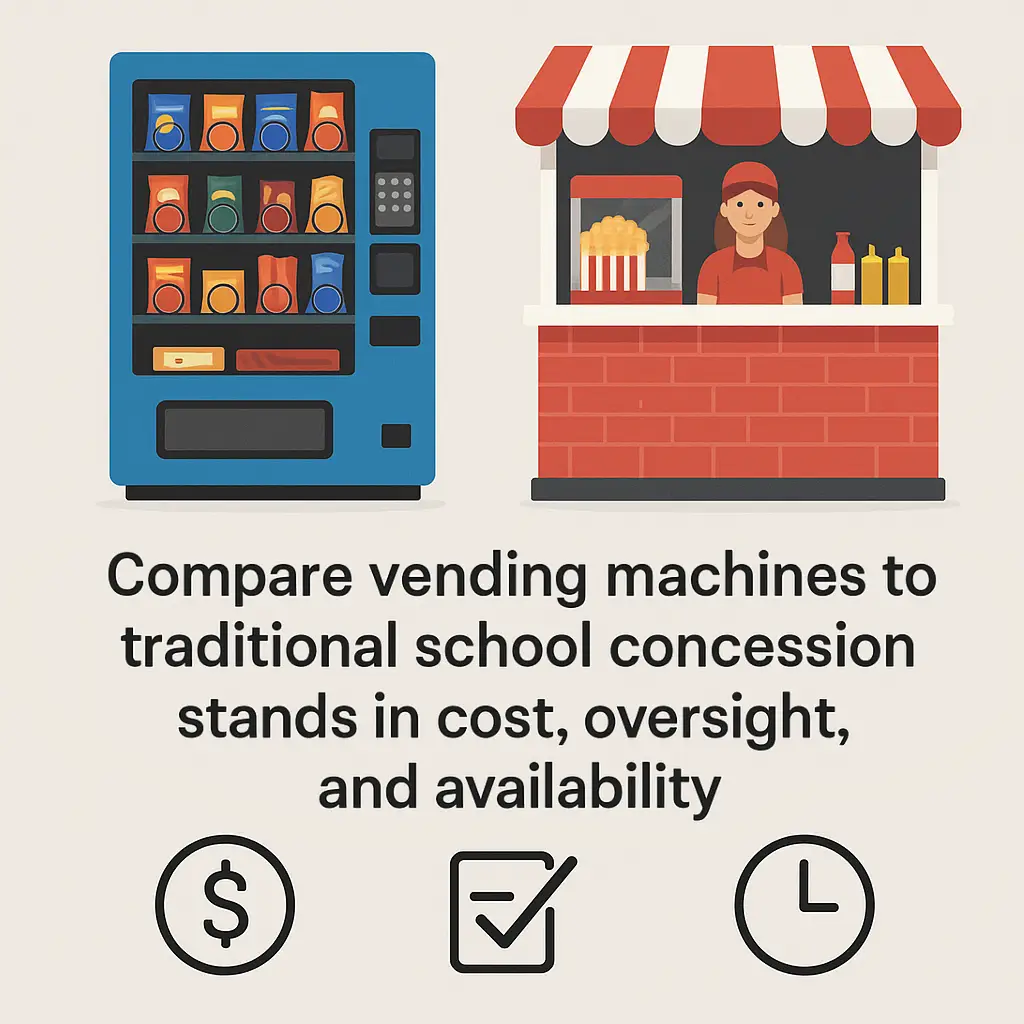School Vending Machines vs Concession Stands
Compare vending machines to traditional school concession stands in cost, oversight, and availability.
Back to Vending for Schools ResourcesCompare vending machines to traditional school concession stands in cost, oversight, and availability.
Back to Vending for Schools ResourcesWhile concession stands involve staffing, spoilage, and cash handling, vending machines reduce these variables. They run autonomously, accept contactless payment, and often come at no cost to schools if usage is consistent.
![]() Vending machines remain accessible before, during, and after school
Vending machines remain accessible before, during, and after school
![]() Concessions often require staffing and close student monitoring
Concessions often require staffing and close student monitoring
![]() Machines offer better portion control and product shelf life
Machines offer better portion control and product shelf life

When evaluating snack and drink distribution in schools, administrators often weigh vending machines against traditional concession stands. Each method comes with its own pros and challenges, particularly around staffing, accessibility, and cost.
Concession stands require school personnel or volunteers to operate, making them labor-intensive. They’re generally open during lunch, breaks, or events, meaning limited student access throughout the day. In contrast, vending machines can run 24/7, giving students and faculty convenient access to snacks, water, or energy drinks whenever needed without additional staffing requirements.
Financially, vending machines tend to be less resource-dependent. Most vending providers offer free installation and servicing to qualified schools. They shoulder the burden of machine maintenance and restocking, which reduces the school’s overhead. Concession stands can generate revenue but bring added expenses such as inventory waste, utilities, and payroll for student workers or supervisors.
Health compliance also plays a larger role today. Many state regulations require specific nutritional standards in school food sales. With the right vending partner, machines can be stocked and programmed to only dispense items that meet these guidelines. Managing compliance is easier with digital reporting and inventory control—not something easily done in more manually operated concessions.
Product variety and safety are equally important. Vending machines offer portioned items with clear labeling and long shelf lives, reducing health or allergy risks. In contrast, manually handled items in concession stands can pose sanitation challenges, especially during busy periods or limited supervision.
When considering student convenience, administrative oversight, and long-term sustainability, vending machines offer a more autonomous and efficient solution for many school environments.
For more on nutritional considerations, check out our piece on state regulations around healthy vending. Or if your facility includes staff breakrooms as well, here’s a look at coffee station planning ideas for schools and workplaces.
If you're exploring vending options for your business, Vending Exchange can help simplify the process. Delivery, Installation and Equipment is provided at no cost to you - vendors provide the machines, keep them stocked, and handle all servicing. Whether you need a provider or full-service management, just fill out the form on this page to get started.
Yes, vending machines typically have no labor costs and free installation, keeping operational expenses lower than concession stands.
Yes, vending machines offer continuous access, allowing students and staff to purchase items outside of limited lunch or event times.
Absolutely. Schools can work with vendors to meet state nutrition guidelines and control product selection and restocking routines.
Most modern school vending machines accept contactless and cashless payments, including credit cards and mobile wallets.
Machines are stocked with shelf-stable or refrigerated items that are rotated regularly to ensure freshness and safety.
They can generate revenue, but require staff time, utilities, and inventory oversight, which affects net profitability.
Vending machines limit direct human handling and come with sealed products, making them more hygienic than hand-served concessions.
Yes, vendors typically manage all maintenance and inventory replenishment, reducing staff workload for schools.
Typical choices include healthy snacks, water, shelf-stable meals, and even nutritious beverages approved for student consumption.
Yes, schools often receive a portion of profits or commissions from items sold within their vending machines.